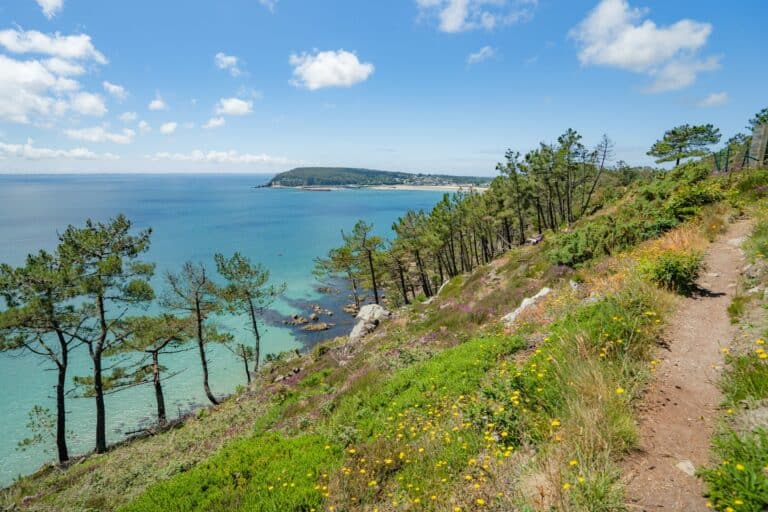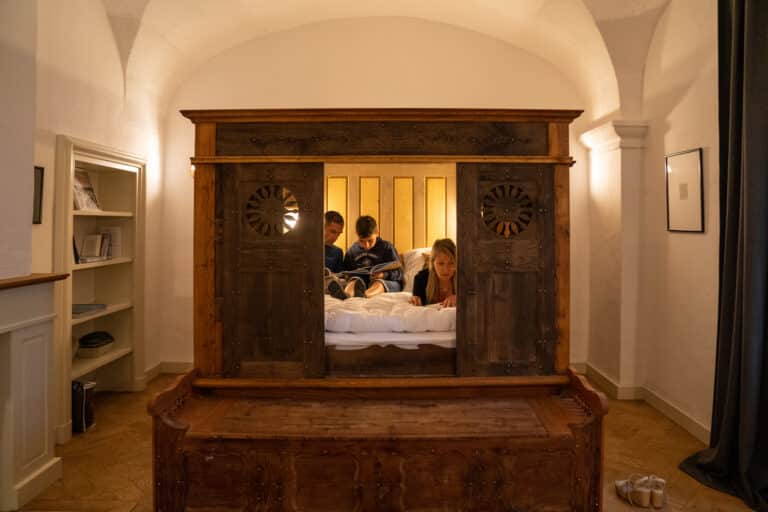Saint Urfold Chapel

Why take advantage?
The chapel
The chapel, located one kilometer northwest of the village on the road to Coat-Méal, is set in a magnificent setting, which also features a fountain and a calvary.
It is thought to date from the 15th century, but it is likely to contain parts of earlier chapel structures.
It contains the Urfold hermit's tomb, which consists of a plain sarcophagus with no inscription, but with an elongated arcade in its interior, through which pilgrims pass again and again. The sarcophagus, raised three feet from the ground, rests on the stone with which Saint-Hervé once covered his uncle's tomb.
Sold during the French Revolution, the chapel was sold to the commune in 1825 by a certain M. Guéna.
In 1841, the commune gave it to the "fabrique" free of charge, so that it could once again be used for worship.
The chapel had just one altar and featured statues of the patron saint, Notre Dame des Douleurs and St-Jean l'Evangéliste.
Over the following decades, the church gradually fell into disrepair, and it took all the self-sacrifice of the Friends of St-Urfold to restore it to health, in particular by decorating it with stained glass windows depicting the hermit's life.
The stained glass windows
The stained glass windows in the Saint-Urfold and Trépassés chapels are the work of Hubert de Sainte-Marie, Master Glassmaker in Quintin. Born in Reims on August 30, 1923, and died in Quintin on April 18, 1991, Hubert de Sainte-Marie, grand-nephew of Maréchal Lyautey, spent his summers in Carantec, Brittany, from 1931 to 1936. From 1940 to 1945, his brilliant training at the École des Beaux-Arts in Reims and Paris enabled him to win the 1946 stained-glass competition organized by the Monuments Historiques for the Sacré Coeur in Montmartre. In 1947, at the suggestion of Jean De Bagneux, Mayor of Quintin, and accompanied by his wife Françoise, an artist-decorator, and his first companion Jean Michel Baladi, he set up his studio on the upper floors of the 17th-century château in Quintin.
Saint-Urfold
According to tradition, he was born in Landouzan in the commune of Drennec around the 6th century, and trained for religious life at the Ack monastery. St Urfold was the brother of Rivanone, mother of St Hervé honored at Lanhouarneau, and the brother of St Rivoaré, who gave his name to the neighboring parish of Lanrivoaré.
Saint-Urfold lived a solitary life in the Dunan forest (from the Breton Doun: deep), which stretched from St-Renan to Plouvien and was decimated, among other things, to build Louis XI's fleet at Brest.
He was a figure of rare sanctity, a hermit who lived apart from society and his family in penance and contemplation.
The historian Albert Le Grand tells us that, after his death, his oratory and sepulchre were so overgrown that it was no longer possible to discern the exact spot where the holy hermit had been buried.
The Pardon de Saint-Urfold
The Pardon de Saint-Urfold takes place at Pentecost, and is associated with the fair of the local private schools, Notre-Dame and Saint-Yves.
On this occasion, the faithful traditionally pass under the archway of the tomb, invoking Saint-Urfold to cure their rheumatism.
Saint Urfold Chapel
Saint-Urfold29860 Bourg-Blanc



















